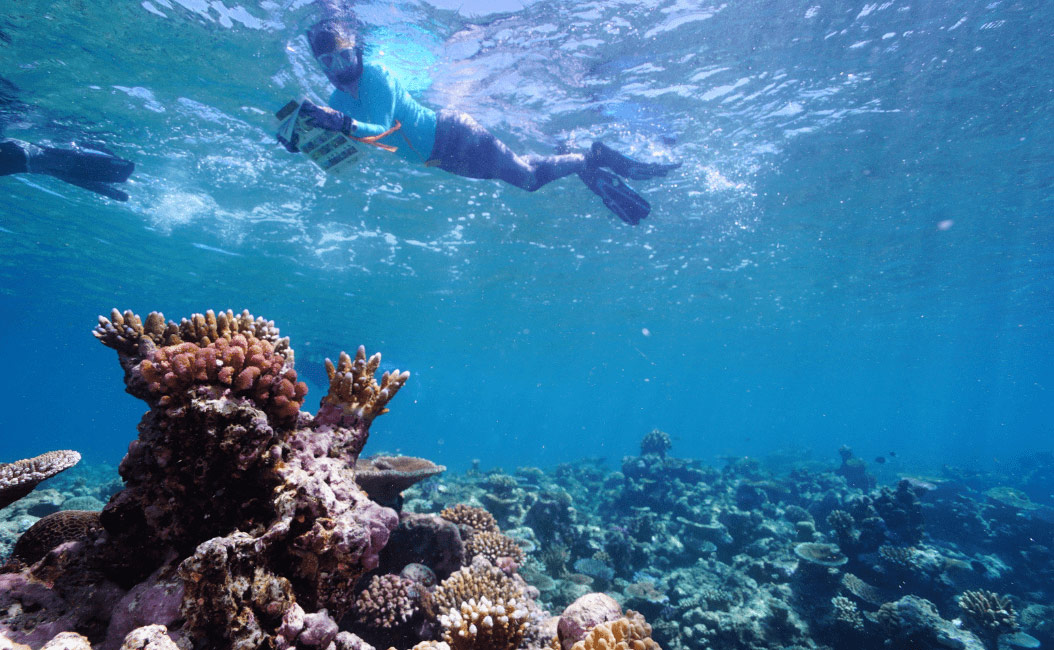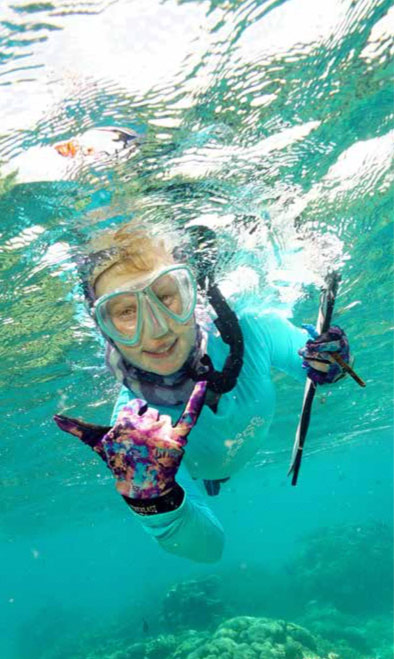
Alicia Urwin: Marine Biologist & Master Reef Guide Quicksilver Connections
What’s your earliest memory about loving the sea?
My earliest memory of loving the sea comes from some books I got when I was six years old, living in inland rural Victoria. Written by Steve Parish, one was about the rainforest and the other, the ocean. For some reason I was very drawn to those books and loved reading and re-reading about all the animals that lived in the ocean.
How do you see your role as a Quicksilver Marine Biologist?
As an educator and ambassador! So many visitors come to the Great Barrier Reef every year. I love to inform them about cool animal facts, but also educate them on the science, impacts and what they (the visitors) can do to help protect its future.
What inspired your journey into marine biology?
I’m the walking cliché, “I’ve wanted to do this since I was a kid!” My favourite characters, dolphins, in the Steve Parish book inspired me, I was just drawn to them! I went to Seaworld in San Diego when I was 10 years old and that sealed the deal. However, I knew then that I wanted to be behind the scenes, to watch and study them. A careers counsellor at high school then helped me identify my pathway into Marine Biology and I will be forever grateful.
How did you find your way to Port Douglas?
I saw a job advertisement for a Marine Biologist in Port Douglas. I will be honest and say I knew next to nothing about Port Douglas, only that it was a town on the Great Barrier Reef and my move there was making my friends jealous! It wasn’t until I arrived here that I saw what all the fuss was about. This place was amazing! It was everything I could have hoped for – warm, tropical, beautiful setting, with heaps to see and do. It reminds me so much of Hawaii. Growing up in an Army family, I’ve lived in a lot of places but I feel more at home here than I have anywhere else in the world.
What advice would you give to people who are considering a career as a Marine Biologist?
Really ask yourself: Why do you want to be a marine biologist? What do you want to achieve? It is very competitive so do everything you can to help yourself stand out. And also volunteer, volunteer, volunteer! If you can get your minimum divemaster diving certification and coxswain commercial boat licence, it really does put your foot ahead of others who may not have those certificates.
What is your favourite marine species and why?
In case you haven’t guessed yet – dolphins! I love dolphins, more importantly I love their intelligence. They are only one of three species known to actually have names for themselves and others in their pods (the others are apes and humans). Their social structures are very similar to ours but they have the handicap of being mammals in an environment that doesn’t allow them to hold their breath forever, so learning about how they have to navigate their ocean home and yet still obtain such intelligence and social structures is fascinating.
What made you want to become an accredited Master Reef Guide?
I loved the concept and wanted to be a part of that. I found it amazing that the Federal Government took a select group of people who worked up and down the Reef and trained them to be “the best of the best”. This awesome group of people with their extensive raw knowledge were taken to a special intensive one-week field school where they were trained by experts from the Great Barrier Reef Marine Park Authority (GBRMPA). I saw it as an amazing opportunity to fully hone my marine environment interpretation skills so visitors to the Reef had the full knowledge of not just myself, but also the research collected from GBRMPA.
An interesting part of training was also the communication aspects. We did lessons and classes on how to just deliver information, and it was wild to learn how even something small as a hand gesture could be interpreted by visitors. Learning just how to posture your body to speak clearly was definitely eye-opening.
I see this accreditation also helping me to mentor new and upcoming Marine Biologists. Assisting them with their confidence and encouragement, as the new ambassadors of the Great Barrier Reef.
Can you share a quirky fact that our readers might be interested to learn?
A quirky fact for your readers to learn is that some nudibranchs (a type of sea slug) actually have the ability to absorb the stinging cells of their prey! Some nudibranchs feast on hydroids (a group of stinging animals such as fire corals) and rather than digest the sting cells, transfer those stinging cells to their skin to create their own protection from any predators they may face. Pretty impressive for a little slug often no bigger than ten centimetres!
What is the most important message about the reef and its future?
The most important message about the Reef is that it is very resilient and can very easily adapt to pressure changes, but as with any living creature it needs time to do so. It has been doing it for thousands of years. It is only in the last 20- 30 years that the Reef has not had adequate time to recover from major events such as bleaching and crown-of-thorn star outbreaks. So, we need to do all we can to help reduce these pressures and impacts and allow our Reef the time it needs to recover like it has shown it is capable of in the past.
Are you involved in any special marine research projects?
I am currently involved in the GBRMPA Eye of The Reef program. Each week I participate in two major research projects: the Tourism Weekly Monitoring and the Rapid Health and Impact Surveys. The Tourism Weekly Monitoring involves completing a set route in a 20-minute snorkel or dive every week, counting any important key indicator species such as grazing herbivorous fish and recording any coral health impacts such as disease, bleaching or predation.
“The reef... is very resilient and can very easily adapt to pressure changes, but as with any living creature it needs time to do so”
The Rapid Health Impact Surveys are conducted at a different site each quarter along our dive/ snorkel sites and involve setting up three x 10 metre diameter circles, and within each circle spending 20 minutes doing an in-depth record of the composition of the sea floor, including coral cover. From there, percentages are worked out of how much the coral cover is living, any bleaching or disease, or any evidence of predation from the crown-of-stars starfish or the Drupella sea snail.
Who are your marine role models?
My biggest marine biologist role model would have to be Jaques Cousteau. His groundbreaking innovations into SCUBA really helped progress the field of marine biology. I also really admire Lars Bedjer, a marine mammalogist who specialises in dolphin research. He has made some truly fascinating observations in dolphin behaviour.
What is on your travel and experiences bucket list?
My current Top Three:
1. Dive the Coral Triangle, especially the reefs of The Philippines
2. Do a Live Aboard on the Red Sea and dive the coral reefs there
3. Visit the Galapagos, especially the Charles Darwin Museum
Any final messages?
The biggest question I get is, “What can I do to help the Reef? I’m just one person!”. Yes, you may be one person, but when you get home ... imagine, if you tell your family what you learnt about the Reef, who then tell their friends, who then tell their own family and friends ... suddenly one person becomes hundreds, which could become thousands. One person CAN make a difference, and by leading by example and sticking to your principles you may just be the inspiration to change another’s habits for the better. Keep learning everything you can, do your best to change your lifestyle to help towards a better environment and don’t be afraid to stick up for yourself and educate others.
You can be the advocate for a better future!


